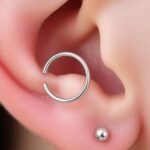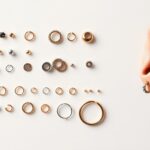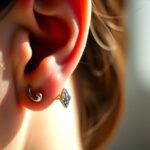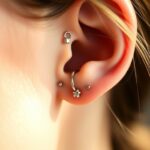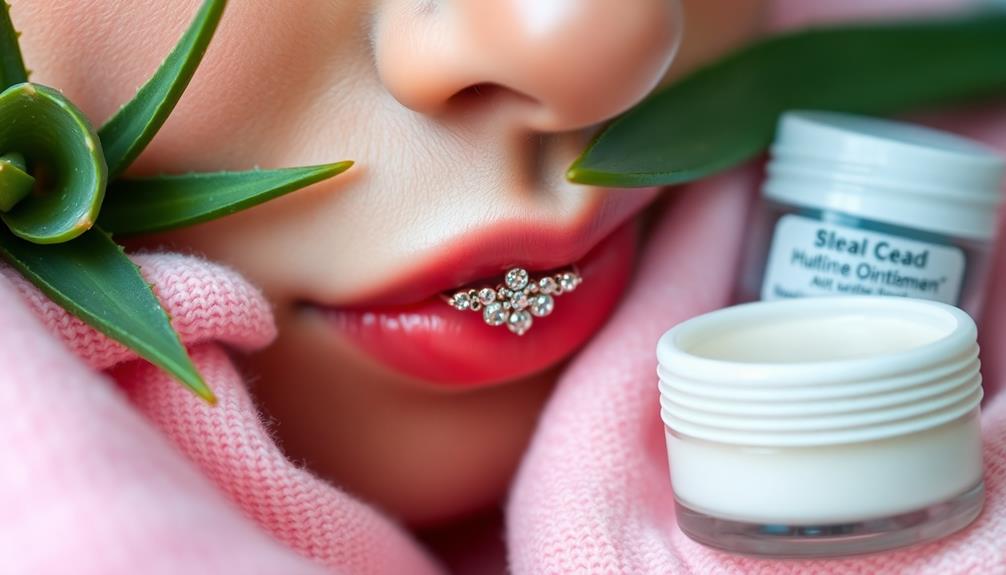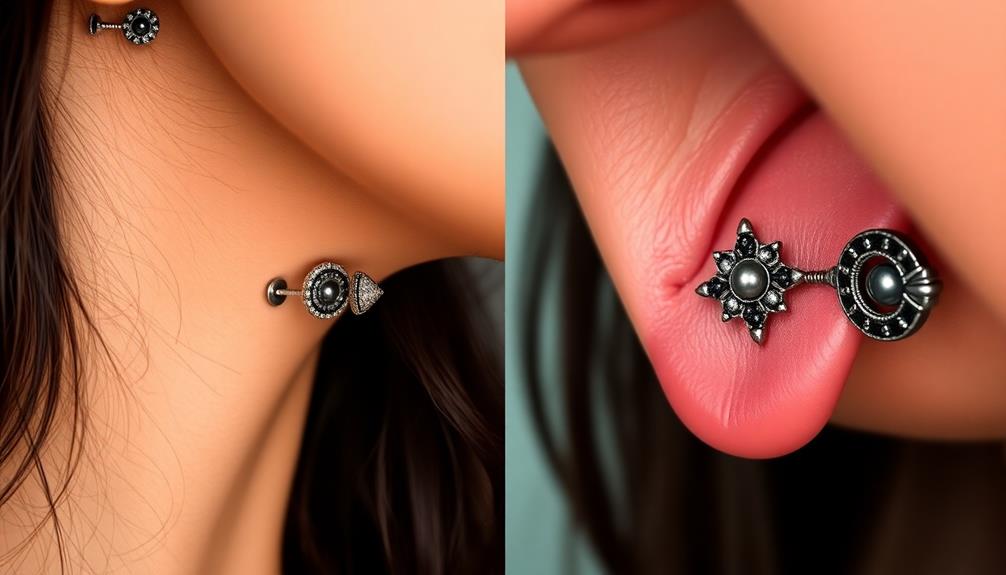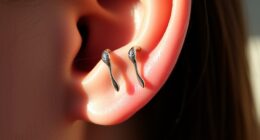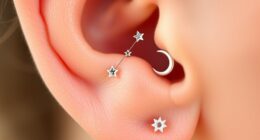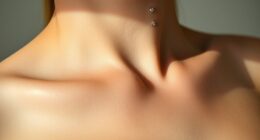Helix piercings offer a stylish way to showcase your personality, with options including single, double, and triple styles. A single helix is a classic choice, while a double helix creates a layered look. For a bolder statement, consider a triple helix piercing. Each style allows for unique jewelry combinations—choose from flat back studs or seamless hoops. The piercing process is straightforward but can involve some discomfort. Aftercare is essential for proper healing, which can take six months to a year. Curious about the best jewelry options and tips for styling? There's much more to explore!
Key Takeaways
- Single Helix Piercing: The most common option, featuring one piercing on the upper outer cartilage for a subtle, stylish look.
- Double Helix Piercing: Consists of two piercings stacked vertically, allowing for versatile jewelry combinations and layered aesthetics.
- Triple Helix Piercing: A bolder choice with three vertical piercings, making it an eye-catching option for those who want to stand out.
- Forward Helix Piercing: Located on the inner cartilage close to the front of the ear, it can be styled as a double or triple piercing.
- Jewelry Options: Popular choices include flat back studs and seamless hoops, with high-quality materials like titanium recommended for comfort and reduced allergy risks.
Types of Helix Piercings

When considering helix piercings, you'll find a variety of options that cater to different styles and preferences. The Single Helix Piercing is the most common choice, featuring one piercing along the upper outer cartilage of the ear. It offers a subtle yet stylish look that many love.
If you're after something bolder, the Double Helix Piercing stacks two piercings vertically in the same area, allowing for versatile helix jewelry combinations and layered aesthetics.
For those who want to make a statement, the Triple Helix Piercing consists of three piercings arranged vertically, providing an eye-catching option.
If you prefer a different angle, consider the Forward Helix Piercing, which is positioned on the inner cartilage closer to the front of your ear. This piercing can also be done as a double or triple for added flair.
Lastly, the Mid Helix Piercing is located in the middle of the ear's outer rim, offering a unique placement for jewelry that sets it apart from standard options.
With these choices, you can find the perfect helix piercing that expresses your style and personality!
Piercing Process and Pain

Choosing the right helix piercing is just the beginning; understanding the piercing process and pain involved is equally important. When you're ready to get your helix piercing, a professional piercer will use a sterile needle to create a hole in the cartilage. This method is preferred over piercing guns for better hygiene and accuracy.
Expect pain levels to be around 5 out of 10, with the sensation usually described as a quick pinch or sting.
After the initial piercing, you might experience some tenderness and swelling, but don't worry—it typically subsides within a few days to a week. To minimize discomfort during the healing process, it's vital to use high-quality jewelry, such as labret studs or flat back designs.
Following aftercare instructions is important for infection prevention since cartilage piercings have a higher risk of irritation compared to lobe piercings.
Healing and Aftercare

Healing a helix piercing requires careful attention to aftercare practices to guarantee a smooth recovery.
The healing time for helix piercings ranges from six to twelve months, so it's important to establish a proper aftercare routine right from the start. Clean your piercing twice daily with a saline solution or an earring cleaning spray to keep the area free from bacteria and irritation.
Avoid sleeping on the newly pierced side to minimize pressure and irritation during the healing process.
It's vital to monitor for any signs of infection, such as increased redness, swelling, or discharge. If you notice any concerning symptoms, consult a professional piercer immediately.
Jewelry Options and Care

Once your helix piercing has fully healed, you'll want to explore the various jewelry options available to express your style. Popular helix jewelry includes flat back studs, captive bead rings, and seamless hoops.
When choosing helix piercing jewelry, you should look for high-quality materials like titanium or 316L surgical stainless steel to minimize allergy risks and guarantee durability.
It's typically recommended to wait between 6 to 12 months for your piercing to heal before shifting from initial jewelry to more elaborate styles. This helps avoid irritation or complications.
For comfort, select a gauge of 16G or 18G, with hoop inner diameters ranging from 6mm to 10mm and stud barbell lengths of 6mm to 10mm.
To keep your jewelry collection in great shape, regular cleaning is essential. Use mild soap and water or a saline solution to clean your helix jewelry daily, which will help avoid infection and maintain hygiene during the healing process.
With the right care and the perfect pieces, your helix piercing can shine beautifully as a reflection of your personal style.
Cost and Styling Tips

Cost plays a significant role in your helix piercing journey, influencing both your initial investment and future styling choices. The average cost for a helix piercing typically ranges from $40 to $80, depending on the studio and the piercer's experience.
For your initial jewelry, it's often best to choose flat back studs made from implant-grade titanium, as they promote a smoother healing process.
Once your piercing has healed, you can fully explore various helix piercing jewelry options. Styling combinations can include simple studs, thin hoop earrings, or ear cuffs, allowing for a personalized ear aesthetic.
If you opt for a double or triple helix, mixing different metals and gemstones can add flair. Just remember to take into account the size and gauge of your jewelry—standard sizes are 16G or 18G, with hoop diameters between 6-10mm for comfort.
After the healing period, feel free to experiment with diverse jewelry styles, from dainty designs to bold statement pieces. Each addition can enhance your overall look and help you create a unique ear stack that reflects your personal style.
Frequently Asked Questions
What Is a Double or Triple Helix Piercing?
A double or triple helix piercing involves stacking two or three piercings in your ear's cartilage. This creates a stylish look, allowing you to mix and match different jewelry while showcasing your unique personality.
Is It Better to Get a Double Helix Piercing in One Ear or Both?
When deciding between a double helix piercing in one ear or both, consider your style preference, healing comfort, and how often you change jewelry. It's all about what feels right for you and your aesthetic!
How Many Helix Piercings Can You Get at Once?
You can get multiple helix piercings at once, but it really depends on your ear's size and shape. Starting with one or two is best to guarantee proper healing and minimize complications.
What Piercing Combos With Helix?
You can create stunning ear looks by combining helix piercings with tragus or conch piercings. Mixing different jewelry styles, like studs and hoops, enhances your unique aesthetic and makes your ear stand out beautifully.
Conclusion
To sum up, whether you opt for a single, double, or triple helix piercing, it's important to reflect on your style and comfort. For instance, Sarah, who chose a triple helix, found that mixing gold hoops and silver studs created a unique look that reflected her personality. Remember to follow proper aftercare and choose quality jewelry to keep your piercings looking fresh. With the right approach, your helix piercings can be a stunning expression of your individuality!
Hi, my name is Danielle, and I’m an author for piercings-body.com. I have a passion for writing and love to share my knowledge on all things body piercing-related. I’m also a huge advocate for safe body modification practices and believe everyone should be able to make informed decisions about their bodies. When I’m not writing or blogging, I enjoy spending time with my family and friends, practicing yoga, and exploring new places.




